Discussion on the Relationship between Debris Flow Provenance Particle Characteristics, Gully Slope, and Debris Flow Types along the Karakoram Highway
Abstract
:1. Introduction
2. Materials and Methods
2.1. Overview of Debris Flows along the Karakoram Highway
2.2. Obtaining the Basic Data of Debris Flow Gully Slope and Provenance Particle Characteristics
- (1)
- Assuming that the average particle size in the three directions of length, width, and height of the debris flow source are , , and , respectively. The equivalent volume diameter method can be used to obtain:
- (2)
- The provenance average particle equivalent diameter of the debris flow along the Karakoram Highway can be obtained as :
3. Results and Discussion
3.1. Variation Law of Debris Flow Provenance Particle Characteristics along the Karakoram Highway
- (1)
- The area where the rain type debris flow is developed is located in the subtropical climate zone, with high temperature but a small temperature difference, weak physical weathering, and ice and snow freezing and thawing, so the damaging effect on rock and soil particles is relatively small, and the provenance average particle equivalent diameter is relatively large;
- (2)
- The distribution area of the glacier ice lake break type debris flow belongs to the typical inland plateau mountain climate, with small precipitation, thin air, strong solar radiation, low temperature and very large temperature difference, and strong physical weathering, and ice and snow freezing and thawing. At the same time, they are mainly started by glaciers, and there is strong friction between glaciers and particles, which has a strong destructive effect on rock and soil particles, so the provenance average particle equivalent diameter is small;
- (3)
- The distribution area of the rain glacier type debris flow lies between the areas where rain type debris flow and glacier ice lake break type debris flow develop. The weather, physical weathering, and the ice and snow freezing and thawing effects of this type of debris flow are also intermediate between the two types. As a result, the provenance average particle equivalent diameter of this type of debris flow is between the other two types of debris flow. Analyzing these characteristics can help us better understand the differences and features of different types of debris flow, and develop effective prevention and response measures;
- (4)
- The freeze–thaw type debris flow is mainly distributed in the section of the Karakoram Highway at an altitude of more than 4000 m. On the one hand, this section belongs to a typical alpine permafrost area, with thick permafrost depth, low temperature and large temperature difference, strong physical weathering, and ice and snow freeze–thaw effect. On the other hand, its surface material is mainly fine sandy soil with rich clay particles, and the larger particles are almost completely wrapped by the surface fine sandy soil. It weakens the damage of physical weathering and ice and snow freezing and thawing on these rocks and soils, so the provenance average particle equivalent diameter of the freeze–thaw debris flow in this section is relatively large, which also explains why the variation trend of the average particle size of the freeze–thaw debris flow source developed on the Karakoram Highway is larger than that of the glacier ice lake break type debris flow.
3.2. Relationship between Particle Characteristics of Debris Flow Source, Gully Slope, and Debris Flow Type
3.2.1. Rain Type Debris Flow
3.2.2. Rain Glacier Type Debris Flows
3.2.3. Glacier Ice Lake Break Type Debris Flows
3.2.4. Freeze–Thaw Type Debris Flows
3.3. Thoughts and Suggestions on Debris Flow Disasters
4. Conclusions
- The provenance particle size induced by debris flow on the Karakoram Highway is controlled by the type of debris flow. Generally, the provenance average particle equivalent diameter of the glacier ice lake break debris flow is relatively small, followed by the freeze–thaw and rain glacier debris flow, and the rain type debris flow is relatively large;
- This analysis shows that the slope coefficient of debris flow gullies along the Karakoram Highway is greater than 1, and it increases as the gully slope becomes steeper. In other words, gullies with higher slope coefficients have steeper slopes;
- The majority of debris flows that occur along the Karakoram Highway can be categorized into four types: rain type debris flows, rain glacier type debris flows, glacier ice lake break type debris flows and freeze–thaw type debris flows. These types of debris flows are characterized by their gully slope coefficient and the provenance average particle equivalent diameter , which are distributed in an elliptical patterns. By analyzing these ellipses, we can better understand the relationship between the gully slope of each type of debris flow and the corresponding provenance particle characteristics.
Author Contributions
Funding
Data Availability Statement
Conflicts of Interest
References
- John, M. Karakoram Highway; Lonely Planet: Melbourne, VIC, Australia, 1998; pp. 10–25. [Google Scholar]
- John, M. Trek in Karakoram and Hindu Kush; Lonely Planet: Melbourne, VIC, Australia, 2002; pp. 5–6. [Google Scholar]
- Star Island Global Network. Karakoram Highway Is About to be Rebuilt and Expanded. Available online: https://web.archive.org/web/20080911030508/http://www.singtaonet.com/global/global_sp/t20060417_192420.html (accessed on 9 February 2023).
- Multidimensional News. Expending 500 Million Yuan to Expand the China-Pakistan Friendship Road: Only Chinese People Can Do It. Available online: https://web.archive.org/web/20220311222845/http://ww5.chinesenewsnet.com/ (accessed on 9 February 2023).
- Ding, M.H.; Huai, B.J.; Sun, W.J.; Wang, Y.T.; Zhang, D.Q.; Guo, X.Y.; Zhang, T. Surge-type glaciers in Karakoram Mountain and possible catastrophes alongside a portion of the Karakoram Highway. Nat. Hazards 2018, 90, 1017–1020. [Google Scholar] [CrossRef]
- CCCC First Highway Survey and Design Institute. Design Specification for Construction Drawings of Karakoram Highway Reconstruction Project (Lekote-Hongqilapu Section); CCCC First Highway Survey and Design Institute: Beijing, China, 2008; p. 59. [Google Scholar]
- Jiangsu Institute of Seismic Engineering. Report on Seismic Safety Assessment of the Reconstruction Project Site of Pakistan Karakoram Highway (Lekot to Hongqilapu Section); Jiangsu Institute of Seismic Engineering: Beijing, China, 2006; p. 5. [Google Scholar]
- Zhu, Y.Y.; Pan, J.Y.; Li, C.Y.; Yang, Z.Q.; Liao, L.P.; Muhammad, W. Glacier debris flow along China-Pakistan International Karakoram Highway (KKH). Mt. Res. 2022, 40, 71–83. [Google Scholar]
- Zhu, Y.Y.; Li, C.Y.; Yang, Z.Q.; Liao, L.Y.; Waseem, M.; Luo, Z. Glacier Lake Outburst Flood (GLOF) along China-Pakistan International Karakoram Highway (KKH). Mt. Res. 2021, 39, 524–538. [Google Scholar]
- Zhu, Y.Y.; Yang, Z.Q.; Liao, L.Y.; Steve, Z.; Muhammad, W.; Ye, C.Y.; Chen, H.P.; Pang, M. Glacialized geomorphologcial geohazard along China-Pakistan International Karakoram Highway. J. Catastrophol. 2014, 29, 81–90. [Google Scholar]
- Zhu, Y.Y.; Yang, Z.Q.; Zou, S.; Waseem, M.; Ye, C.Y.; Pang, M. Glacier geohazards along China-Pakistan International Karakoram Highway. J. Highw. Transp. Res. Dev. 2014, 31, 51–59. [Google Scholar]
- Liu, Z.Q.; Yang, Z.Q.; Chen, M.; Xu, H.H.; Yang, Y.; Zhang, J.; Wu, Q.; Wang, M.M.; Song, Z.; Ding, F.S. Research hotspots and frontiers of mountain flood disaster: Bibliometric and visual analysis. Water 2023, 15, 673. [Google Scholar] [CrossRef]
- Yang, Z.Q.; Zhao, X.G.; Chen, M.; Zhang, J.; Yang, Y.; Chen, W.T.; Bai, X.F.; Wang, M.M.; Wu, Q. Characteristics, dynamic analyses and hazard assessment of debris flows in Niumiangou Valley of Wenchuan County. Appl. Sci. 2023, 13, 1161. [Google Scholar] [CrossRef]
- Liao, L.P.; Zhu, Y.Y.; Yang, Z.Q.; Muhammad, W.; Steve, Z.; Chen, J.D.; Wang, Y.; Ye, C.Y.; Zhang, X.J. Debris flow hazards and prevention optimization along International Karakoram Highway. Geol. Sci. Technol. Inf. 2013, 32, 168–174. [Google Scholar]
- Yang, Z.Q.; Zhu, Y.Y.; Qian, S.G.; Hou, K.P. Types and space distribution characteristics of debris flow disasters along China-Pakistan highway. Electron. J. Geotech. Eng. 2016, 21, 191–200. [Google Scholar]
- Chengdu Institute of Mountain Hazards and Environment, Ministry of Water Resources, Chinese Academy of Sciences. Investigation Report on Geological Hazards of KKH Highway in 2009; Chengdu Institute of Mountain Hazards and Environment, Ministry of Water Resources, Chinese Academy of Sciences: Chengdu, China, 2009; p. 23. [Google Scholar]
- Li, X.S.; Peng, J.; Xie, Y.L.; Li, Q.H.; Zhou, T.; Wang, J.W.; Zheng, W. Influence of high-temperature treatment on strength and failure behaviors of a quartz-rich sandstone under true triaxial condition. Lithosphere 2022, 2022, 3086647. [Google Scholar] [CrossRef]
- Li, T.; Zhou, Y.C.; Zhu, J.; Liu, J.P. Effect of fine aggregate gradation on the rheology of mortar. Constr. Build. Mater. 2022, 332, 127362. [Google Scholar] [CrossRef]
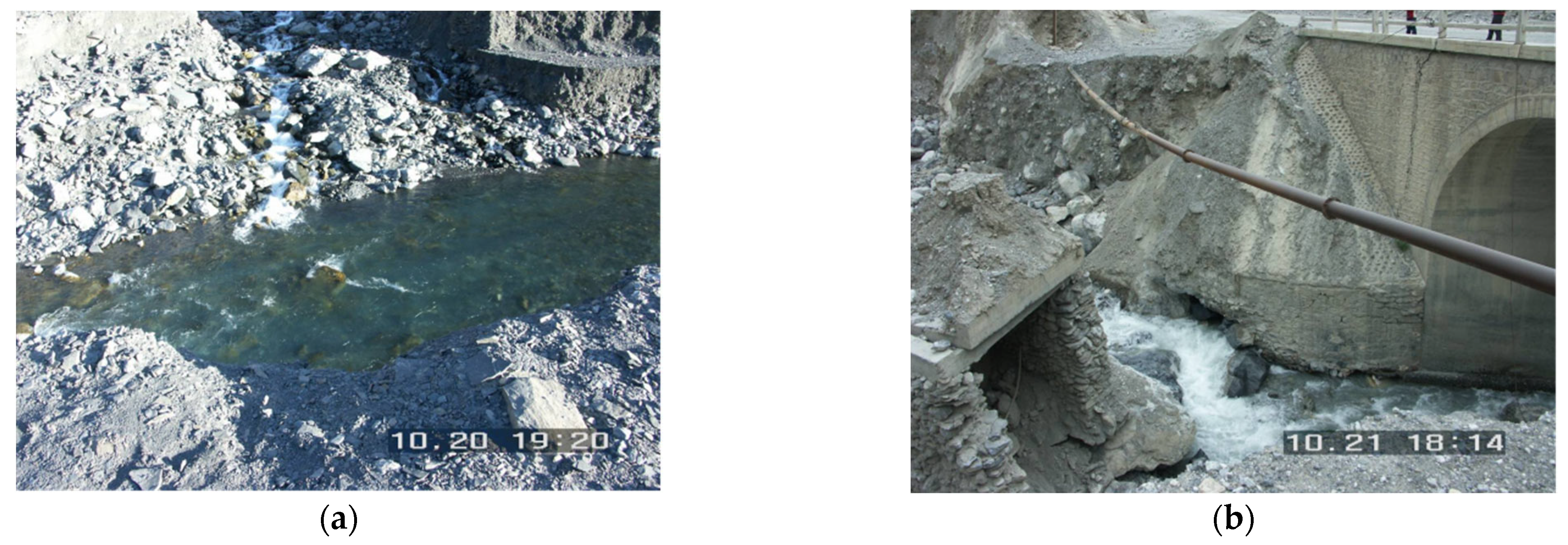

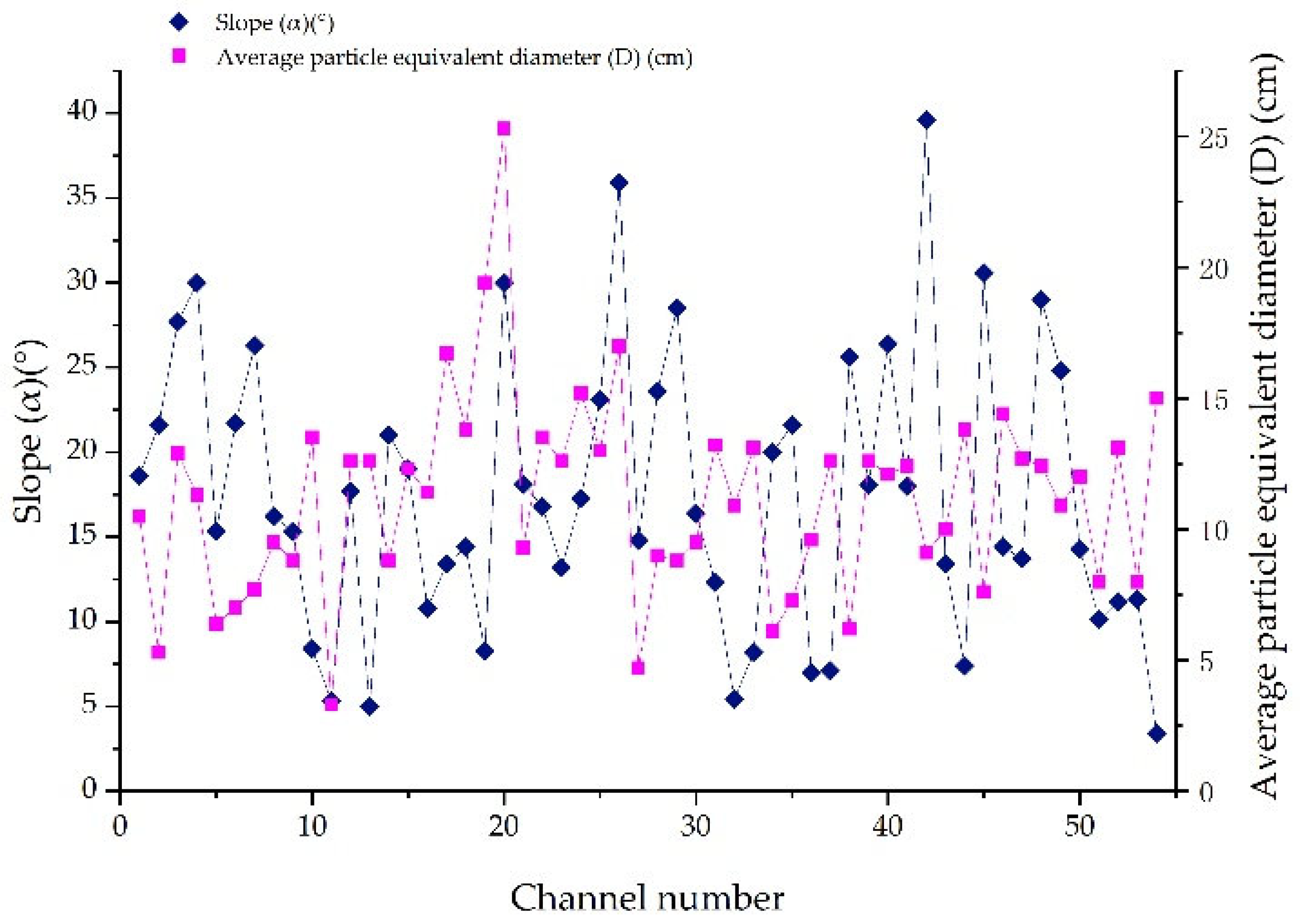
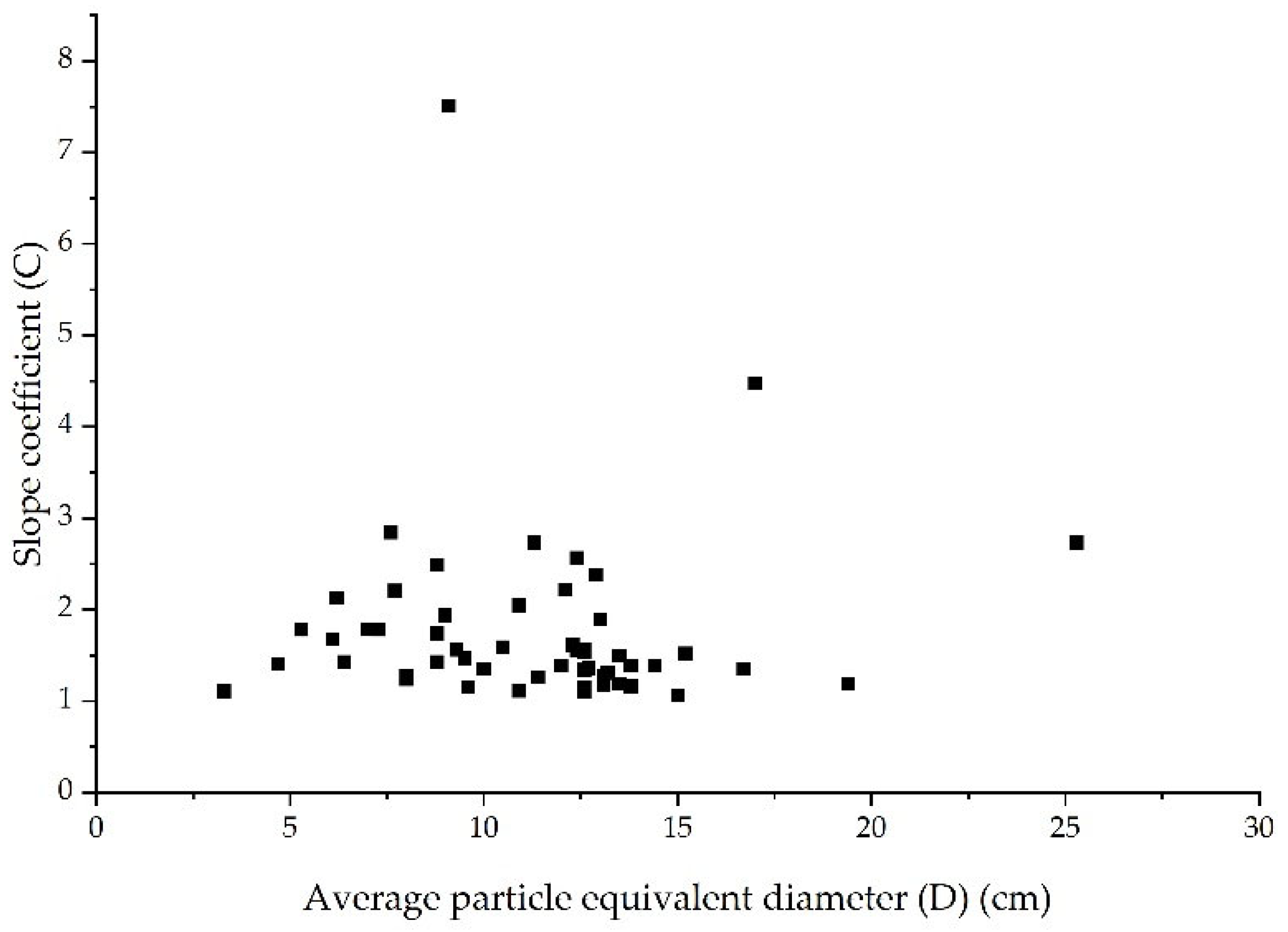

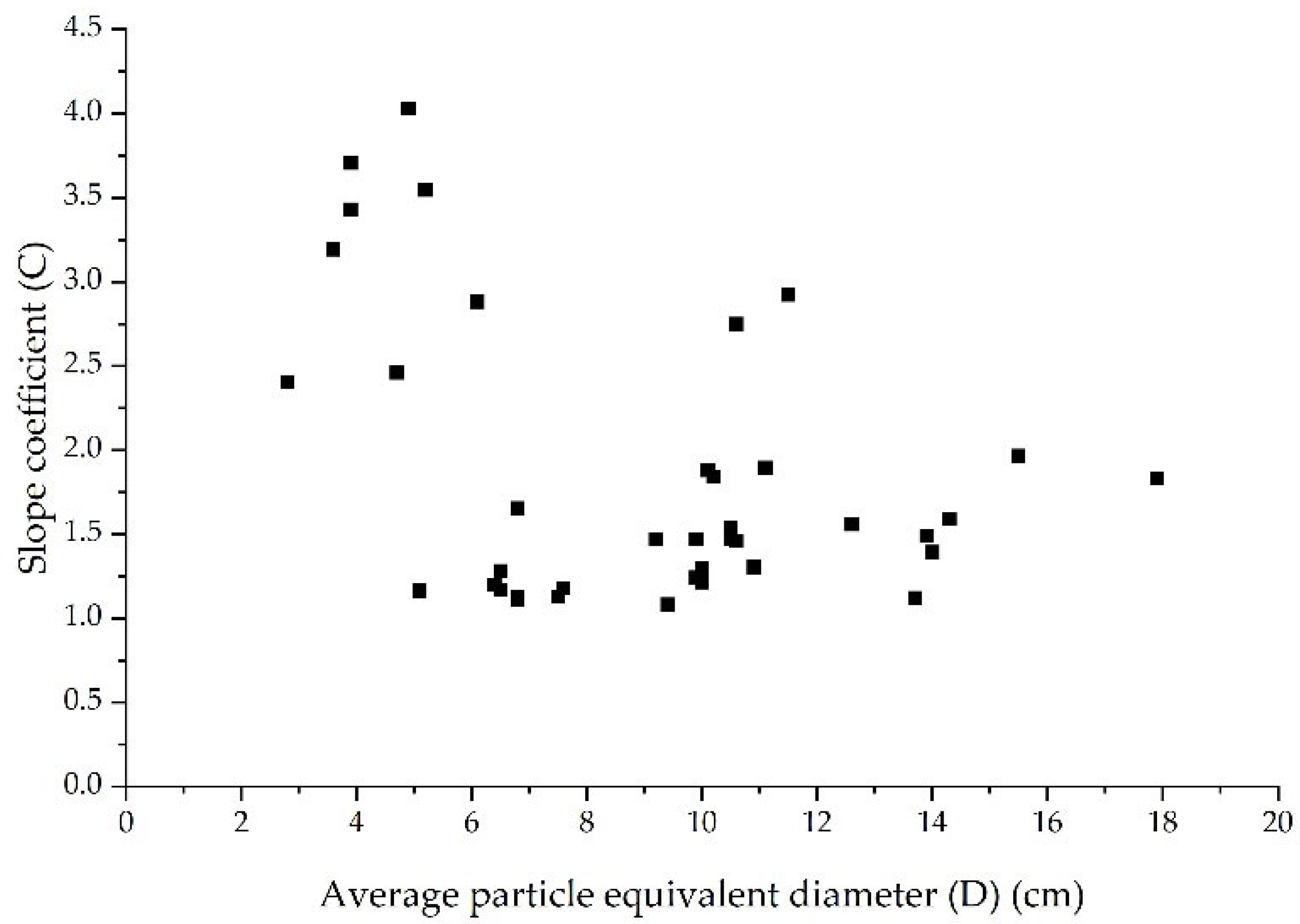
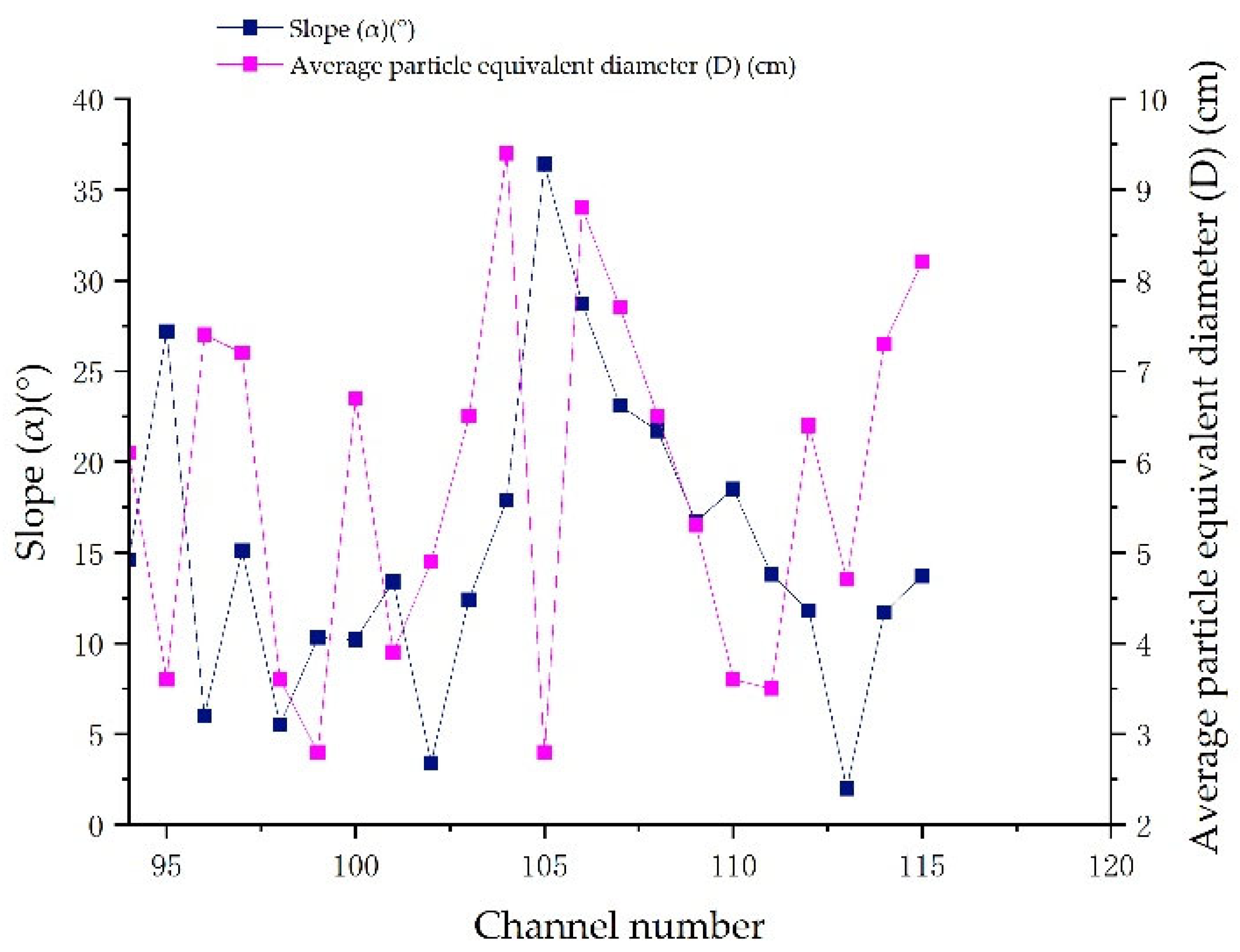
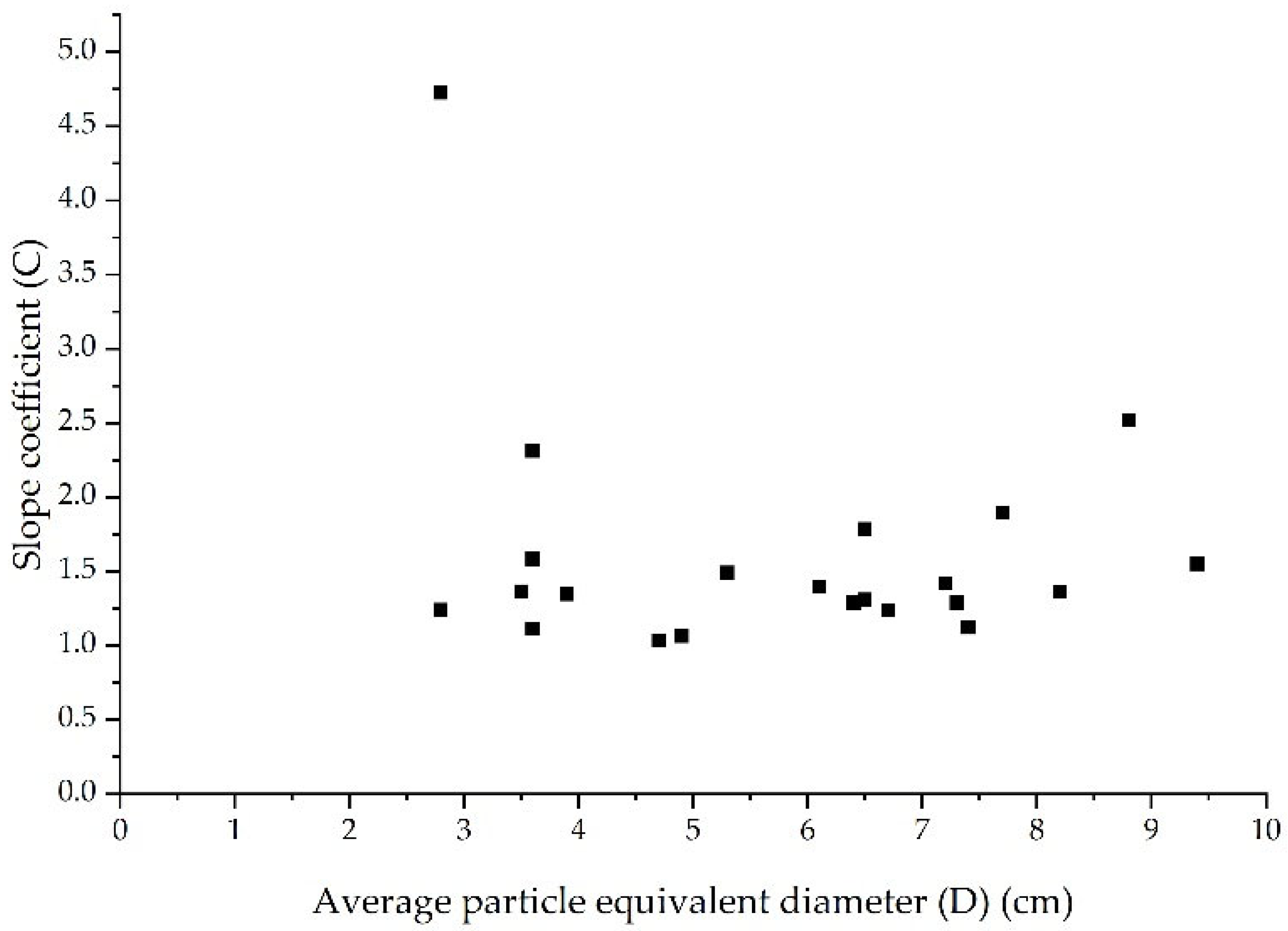
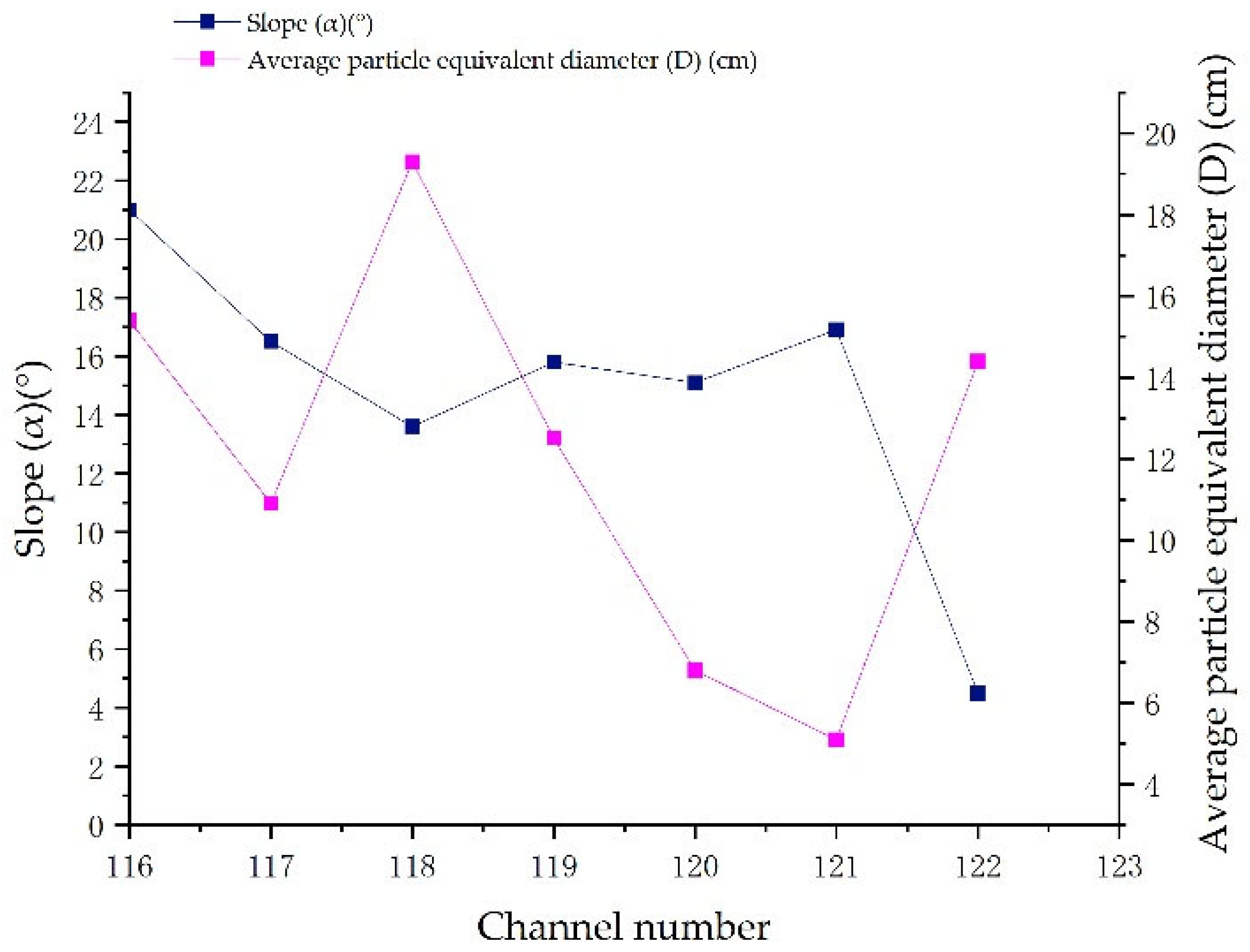

| Debris Flow Type | Distribution Interval |
|---|---|
| Rain type debris flow | Distributed between Raikot (K470+500) and Daynore (K538) |
| Rain glacier type debris flow | Located between Daynore (K538) and Hasnabard (K623) |
| Glacier ice lake break type debris flow | Distributed between Hasnabard (K623) and Gosghil (K796) |
| Freeze–thaw type debris flow | Located between Gosghil (K796) and Khongjirap (K811) |
| Debris Flow Type | Channel Number | Highway Stake Number | Slope (α) (°) | Average Particle Size (cm × cm × cm) | Average Particle Equivalent Diameter () (cm) | |
|---|---|---|---|---|---|---|
| Rain type debris flows | 1 | K471+860 | 18.6 | 12 × 10 × 5 | 10.5 | |
| 2 | K473+521 | 21.6 | 5 × 8 × 2 | 5.3 | ||
| 3 | K475+270 | 27.7 | 16 × 10 × 7 | 12.9 | ||
| 4 | K475+950-K476+125.3 | 30 | 8 × 13 × 7 | 11.3 | ||
| 5 | k477+896 | 15.3 | 5 × 9 × 3 | 6.4 | ||
| 6 | K477+380 | 21.7 | 9 × 10 × 2 | 7.0 | ||
| 7 | K478+250 | 26.3 | 6 × 10 × 4 | 7.7 | ||
| 8 | K479+840 | 16.2 | 10 × 9 × 5 | 9.5 | ||
| 9 | K480+036.1 | 15.3 | 15 × 6 × 4 | 8.8 | ||
| 10 | K481+525-K481+550 | 8.4 | 13 × 14 × 7 | 13.5 | ||
| 11 | K483+41-K483+468 | 5.3 | 3 × 1.5 × 4 | 3.3 | ||
| 12 | K486+670 | 17.7 | 10 × 13 × 8 | 12.6 | ||
| 13 | K489+700-740 | 5 | 15 × 7 × 10 | 12.6 | ||
| 14 | K490+050 | 21 | 12 × 5 × 6 | 8.8 | ||
| 15 | K490+225 | 19 | 13 × 15 × 5 | 12.3 | ||
| 16 | K491+70-k491+900 | 10.8 | 16 × 7 × 7 | 11.4 | ||
| 17 | K493+692-710 | 13.4 | 13 × 17 × 11 | 16.7 | ||
| 18 | K494+15-K494+185 | 14.4 | 14 × 11 × 9 | 13.8 | ||
| 19 | K496+650 | 8.3 | 13 × 14 × 21 | 19.4 | ||
| 20 | K496+820 | 30 | 31 × 21 × 13 | 25.3 | ||
| 21 | K503+723.5 | 18.1 | 13 × 8 × 4 | 9.3 | ||
| 22 | K504+731-772 | 16.8 | 11 × 13 × 9 | 13.5 | ||
| 23 | K504+860-872 | 13.2 | 9 × 13 × 9 | 12.6 | ||
| 24 | K505+090 | 17.3 | 17 × 12 × 9 | 15.2 | ||
| 25 | K505+367 | 23.1 | 16 × 6 × 12 | 13.0 | ||
| 26 | K506+100 | 35.9 | 20 × 16 × 8 | 17.0 | ||
| 27 | K506+683 | 14.8 | 11 × 5 × 1 | 4.7 | ||
| 28 | K508+355 | 23.6 | 11 × 7 × 5 | 9.0 | ||
| 29 | K508+577 | 28.5 | 9 × 8 × 5 | 8.8 | ||
| 30 | K508+865.8 | 16.4 | 15 × 10 × 3 | 9.5 | ||
| 31 | K512+980 | 12.3 | 8 × 10 × 15 | 13.2 | ||
| 32 | K515+340 | 5.4 | 16 × 7 × 6 | 10.9 | ||
| 33 34 35 | K518+830- K519+000 | No.1 ditch | 8.2 | 14 × 7 × 12 | 13.1 | |
| No.2 ditch | 20 | 5 × 6 × 4 | 6.1 | |||
| No.3 ditch | 21.6 | 11 × 6 × 3 | 7.27 | |||
| 36 | K519+244 | 7 | 6 × 6 × 13 | 9.6 | ||
| 37 | K519+380 | 7.1 | 13 × 8 × 10 | 12.6 | ||
| 38 | K519+651 | 25.6 | 3.5 × 7 × 5 | 6.2 | ||
| 39 | K519+860 | 18.1 | 12 × 11 × 8 | 12.6 | ||
| 40 | K520+200-220 | 26.4 | 11 × 12 × 7 | 12.1 | ||
| 41 | K520+520 | 18 | 11 × 13 × 7 | 12.4 | ||
| 42 | K521+950 | 39.6 | 19 × 7 × 3 | 9.1 | ||
| 43 | K524+100 | 13.4 | 13 × 10 × 4 | 10.0 | ||
| 44 | K524+960 | 7.4 | 11 × 14 × 9 | 13.8 | ||
| 45 | K525+860-875 | 30.6 | 13 × 9 × 2 | 7.6 | ||
| 46 | K524+103 | 14.4 | 13 × 20 × 6 | 14.4 | ||
| 47 | K526+940 | 13.7 | 12 × 10 × 9 | 12.7 | ||
| 48 | K527+300 | 29 | 15 × 11 × 6 | 12.4 | ||
| 49 | K528+740 | 24.8 | 8 × 14 × 6 | 10.9 | ||
| 50 | K529+670 | 14.3 | 12 × 15 × 5 | 12.0 | ||
| 51 | K530+535 | 10.1 | 9 × 10 × 3 | 8.0 | ||
| 52 | K530+660 | 11.2 | 14 × 17 × 5 | 13.1 | ||
| 53 | K531+900 | 11.3 | 11 × 6 × 4 | 8.0 | ||
| 54 | K535+650-K536+000 | 3.4 | 16 × 11 × 10 | 15.0 | ||
| Rain glacier type debris flows | 55 | K543+210-280 | 4.2 | 18 × 4 × 6 | 9.4 | |
| 56 | K547+300 | 22.4 | 11 × 10 × 5 | 10.2 | ||
| 57 | K547+524 | 18.6 | 17 × 18 × 5 | 14.3 | ||
| 58 | K548+000 | 12.2 | 13 × 13 × 4 | 10.9 | ||
| 59 | K549+000 | 23.9 | 15 × 13 × 10 | 15.5 | ||
| 60 | K549+300 | 10.3 | 9 × 14 × 4 | 9.9 | ||
| 61 | K549+420 | 19.7 | 7 × 8 × 3 | 6.8 | ||
| 62 | K549+605 | 30.1 | 9 × 10 × 7 | 10.6 | ||
| 63 | K549+805 | 14.5 | 11 × 12 × 11 | 14.0 | ||
| 64 | K550+198.5 | 16.3 | 10 × 10 × 6 | 10.5 | ||
| 65 | K550+891 | 23.1 | 18 × 10 × 4 | 11.1 | ||
| 66 | K551+327 | 11.9 | 13 × 10 × 4 | 10.0 | ||
| 67 | K551+671 | 17.6 | 12 × 10 × 5 | 10.5 | ||
| 68 | K551+862 | 22.3 | 20 × 15 × 10 | 17.9 | ||
| 69 | K556+100 | 6 | 6 × 9 × 3 | 6.8 | ||
| 70 | K555+868 | 5.4 | 7 × 8 × 3 | 6.8 | ||
| 71 | K557+540 | 8.2 | 6 × 13 × 3 | 7.6 | ||
| 72 | K559+400 | 5.9 | 15 × 9 × 10 | 13.7 | ||
| 73 | K560+900 | 31 | 11 × 9 × 8 | 11.5 | ||
| 74 | K562+500 | 30.8 | 5 × 8 × 3 | 6.1 | ||
| 75 | K566+860 | 6.2 | 4 × 7 × 8 | 7.5 | ||
| 76 | K569+570 | 9.4 | 6 × 11 × 8 | 10.0 | ||
| 77 | K570+940 | 16.2 | 9 × 9 × 5 | 9.2 | ||
| 78 | K576+300 | 16 | 7 × 18 × 5 | 10.6 | ||
| 79 | K578+839-852.6 | 32.2 | 4 × 6 × 1 | 3.6 | ||
| 80 | K579+874 | 16.7 | 10 × 20 × 7 | 13.9 | ||
| 81 | K581+600 | 27.9 | 1 × 3 × 4 | 2.8 | ||
| 82 | K586+300 | 28.3 | 4 × 7 × 2 | 4.7 | ||
| 83 | K592+920 | 22.9 | 18 × 10 × 3 | 10.1 | ||
| 84 | K593+465 | 16.3 | 15 × 17 × 2 | 9.9 | ||
| 85 | K594+400 | 7.6 | 5 × 7 × 2 | 5.1 | ||
| 86 | K597+879 | 7.8 | 8 × 6 × 3 | 6.5 | ||
| 87 | K599+585 | 8.9 | 5 × 7 × 4 | 6.4 | ||
| 88 | K604+060 | 18 | 15 × 10 × 7 | 12.6 | ||
| 89 | K607+960 | 11.5 | 6 × 3 × 8 | 6.5 | ||
| 90 | K614+921 | 33.5 | 5 × 5 × 3 | 5.2 | ||
| 91 | K615+509 | 34.9 | 6 × 5 × 2 | 4.9 | ||
| 92 | K615+835 | 33.1 | 2 × 5 × 3 | 3.9 | ||
| 93 | K615+930 | 34 | 5 × 3 × 2 | 3.9 | ||
| Glacier ice lake break type debris flows | 94 | K628 | 14.6 | 5 × 6 × 4 | 6.1 | |
| 95 | K653+965 | 27.2 | 2 × 3 × 4 | 3.6 | ||
| 96 | K687+440 | 6 | 7 × 6 × 5 | 7.4 | ||
| 97 | K705+680-720 | 15.1 | 8 × 8 × 3 | 7.2 | ||
| 98 | K709+180 | 5.5 | 4 × 3 × 2 | 3.6 | ||
| 99 | K711+700 | 10.3 | 3 × 2 × 2 | 2.8 | ||
| 100 | K715+654-674 | 10.2 | 5 × 8 × 4 | 6.7 | ||
| 101 | K716+290-320 | 13.4 | 2 × 3 × 5 | 3.9 | ||
| 102 | K717+408 | 3.4 | 3 × 7 × 3 | 4.9 | ||
| 103 | K723+915 | 12.4 | 8 × 9 × 2 | 6.5 | ||
| 104 | K732+200 | 17.9 | 9 × 12 × 4 | 9.4 | ||
| 105 | K744+200 | 36.4 | 3 × 1 × 4 | 2.8 | ||
| 106 | K747+170 | 28.7 | 15 × 4 × 6 | 8.8 | ||
| 107 | K741+755 | 23.1 | 10 × 12 × 2 | 7.7 | ||
| 108 | K756+100 | 21.7 | 8 × 6 × 3 | 6.5 | ||
| 109 | K763+750 | 16.7 | 5 × 8 × 2 | 5.3 | ||
| 110 | K766+600 | 18.5 | 4 × 6 × 1 | 3.6 | ||
| 111 | K771+725-900 | 13.8 | 11 × 1 × 2 | 3.5 | ||
| 112 | K773+500 | 11.8 | 10 × 7 × 2 | 6.4 | ||
| 113 | K776+388 | 2.0 | 7 × 2 × 4 | 4.7 | ||
| 114 | K784+900 | 11.7 | 10 × 10 × 2 | 7.3 | ||
| 115 | K785+760 | 13.7 | 12 × 6 × 4 | 8.2 | ||
| Freeze–thaw type debris flows | 116 | K801+060 | 21 | 20 × 12 × 8 | 15.4 | |
| 117 | K802+048 | 16.5 | 12 × 7 × 8 | 10.9 | ||
| 118 | K802+225 | 13.6 | 25 × 15 × 10 | 19.3 | ||
| 119 | K802+400 | 15.8 | 16 × 8 × 8 | 12.5 | ||
| 120 | K803+588 | 15.1 | 6 × 9 × 3 | 6.8 | ||
| 121 | K806+600 | 16.9 | 5 × 7 × 2 | 5.1 | ||
| 122 | K811 | 4.5 | 15 × 8 × 13 | 14.4 | ||
Disclaimer/Publisher’s Note: The statements, opinions and data contained in all publications are solely those of the individual author(s) and contributor(s) and not of MDPI and/or the editor(s). MDPI and/or the editor(s) disclaim responsibility for any injury to people or property resulting from any ideas, methods, instructions or products referred to in the content. |
© 2023 by the authors. Licensee MDPI, Basel, Switzerland. This article is an open access article distributed under the terms and conditions of the Creative Commons Attribution (CC BY) license (https://creativecommons.org/licenses/by/4.0/).
Share and Cite
Yang, Z.; Wei, L.; Liu, Y.; He, N.; Zhang, J.; Xu, H. Discussion on the Relationship between Debris Flow Provenance Particle Characteristics, Gully Slope, and Debris Flow Types along the Karakoram Highway. Sustainability 2023, 15, 5998. https://doi.org/10.3390/su15075998
Yang Z, Wei L, Liu Y, He N, Zhang J, Xu H. Discussion on the Relationship between Debris Flow Provenance Particle Characteristics, Gully Slope, and Debris Flow Types along the Karakoram Highway. Sustainability. 2023; 15(7):5998. https://doi.org/10.3390/su15075998
Chicago/Turabian StyleYang, Zhiquan, Lai Wei, Yuqing Liu, Na He, Jie Zhang, and Hanhua Xu. 2023. "Discussion on the Relationship between Debris Flow Provenance Particle Characteristics, Gully Slope, and Debris Flow Types along the Karakoram Highway" Sustainability 15, no. 7: 5998. https://doi.org/10.3390/su15075998
APA StyleYang, Z., Wei, L., Liu, Y., He, N., Zhang, J., & Xu, H. (2023). Discussion on the Relationship between Debris Flow Provenance Particle Characteristics, Gully Slope, and Debris Flow Types along the Karakoram Highway. Sustainability, 15(7), 5998. https://doi.org/10.3390/su15075998









